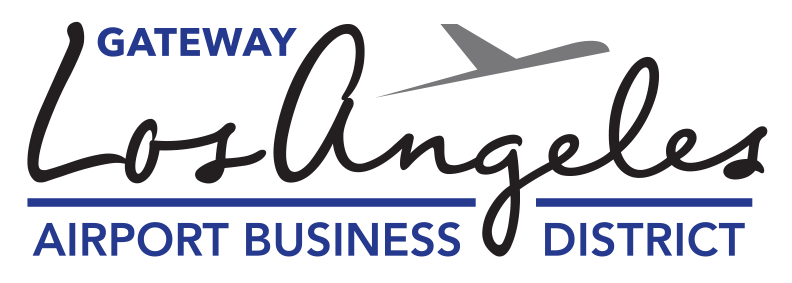The 'shoofly road opened to vehicles and pedestrians on Monday morning.
(Los Angeles, CA) Today, as part of its Landside Access Modernization Program (LAMP) to transform how people access Los Angeles International Airport (LAX), Los Angeles World Airports (LAWA) officially opened to vehicle use an auxiliary road called a “shoofly” on Aviation Boulevard between Arbor Vitae Street and Century Boulevard. The shoofly, one of several enabling projects that are preparing LAX and the surrounding streets for heavy construction, will allow the flow of traffic between Century Boulevard and Arbor Vitae Street to be maintained during construction of the future extension of 98th Street.
The building of an entirely new roadway to detour around the impacted area surpasses typical construction requirements. LAWA airport officials wanted to lessen the impacts of LAMP construction work on guests, airport employees and the surrounding community.
Currently ending at Bellanca Avenue, 98th Street will extend to the 405 Freeway once completed in 2023, providing easy access to the new Consolidated Rent-A-Car Facility and on and off-ramps of the freeway. This roadway extension is one of a number of major roadway improvements LAX is undertaking as part of the $5.5 billion modernization project.
“Opening the shoofly road was a collaborative effort between Los Angeles World Airports, our contractors and multiple city entities, including the Board of Public Works,” said Dan McKelvie, Project Manager, LAWA Utilities and LAMP Enabling Project (LULEP). “There is much more work to do, but this project’s completion is a major step toward extending 98th Street to the 405 Freeway and creating new access points to LAX.”
the building of an entirely new roadway to detour around the impacted area surpasses typical construction requirements. LAWA airport officials wanted to lessen the impacts of LAMP construction work on guests, airport employees and the surrounding community.
The map above shows the Aviation Boulevard 'shoofly' or detour road, which will allow through traffic between Arbor Vitae Street and Century Boulevard during construction of the 98th Street extension.
The extension of 98th Street will run from Bellanca Avenue, under the Metro rail lines and connect to the 405 Freeway.
Paving of the 'shoofly' road.
Pouring concrete for the sidewalks (l) and grading the area prior to paving (r).
With completion of the shoofly, LAWA can now begin several critical utility projects in preparation for future construction of the 98th Street extension. In order to facilitate the extension, Aviation Boulevard must be lowered approximately 15 feet under the Metro Crenshaw/LAX and Green lines, which means multiple underground utilities must be relocated ahead of time.
Several projects to relocate electricity underground have already been completed, while work to relocate a communications line, storm drain, sewer line, reclaimed water line and domestic water line will take place over the next year to allow the roadway extension work to begin.
Along with roadway improvements, LAX’s modernization project includes an Automated People Mover train system, which will feature six stations and connect the terminals to new off-site parking facilities, new drop-off/pick-up locations, a Consolidated Rent-A-Car Facility and direct connection to the regional light rail system.
For all construction impacts, renderings of the projects and more information on LAX’s modernization, visit FlyLAX.com/ConnectingLAX. Individuals can also subscribe to receive email updates online.
About Los Angeles International Airport (LAX)
LAX, the fourth-busiest airport in the world and second busiest in the United States, was named a top-10 U.S. airport by SKYTRAX. LAX served more than 87.5 million passengers in 2018 and offers an average of 700 daily nonstop flights to 109 cities in the U.S. and 1,281 weekly nonstop flights to 93 markets in 47 countries on 69 commercial airlines. LAX ranks 10th in the world in air cargo tonnage processed, with more than 2.4 million tons of air cargo. LAX handled 707,883 operations (landings and takeoffs) in 2018.
LAX generated 620,600 jobs in Southern California, with labor income of $37.3 billion and economic output (business revenues) of more than $126.6 billion, according to an economic study based on 2014 operations. This activity added $6.2 billion to local and state revenues and $8.7 billion in federal tax revenues. The study also reported that LAX’s ongoing capital improvement program creates an additional 121,640 annual jobs with labor income of $7.6 billion and economic output of $20.3 billion; $966 million in state and local taxes; and $1.6 billion in federal tax revenues.
LAX was honored as having the “Best Overall Customer Service Program” by Airports Council International-North America; named the “Best Airport for Breastfeeding Moms” by Mamava; selected for the Top 10 “Best of the U.S.’s Big Airports” (Wall Street Journal) and “Most Pet-Friendly Airports in the U.S. (Mental Floss); named the second-most improved airport in the U.S. by JD Power; received an “Innovation Award” from the L.A. Better Business Challenge for its Central Utility Plant; and named a “Business Leader in Air Quality” by the South Coast Air Quality Management District.
LAX is also the second-most popular airport in the world to appear on Instagram, according to wego.com. LAX is part of a system of two Southern California airports – along with Van Nuys general aviation – that are owned and operated by Los Angeles World Airports, a proprietary department of the City of Los Angeles that receives no funding from the City’s general fund.
For more information about LAX, please visit www.flyLAX.com or follow on Twitter @flyLAXAirport, on Facebook at www.facebook.com/LAInternationalAirport, and on YouTube at www.YouTube.com/laxairport1.
As a covered entity under Title II of the Americans with Disabilities Act, the City of Los Angeles does not discriminate on the basis of disability and, upon request, will provide reasonable accommodation to ensure equal access to its programs, services, and activities. Alternative formats in large print, braille, audio, and other forms (if possible) will be provided upon request.













